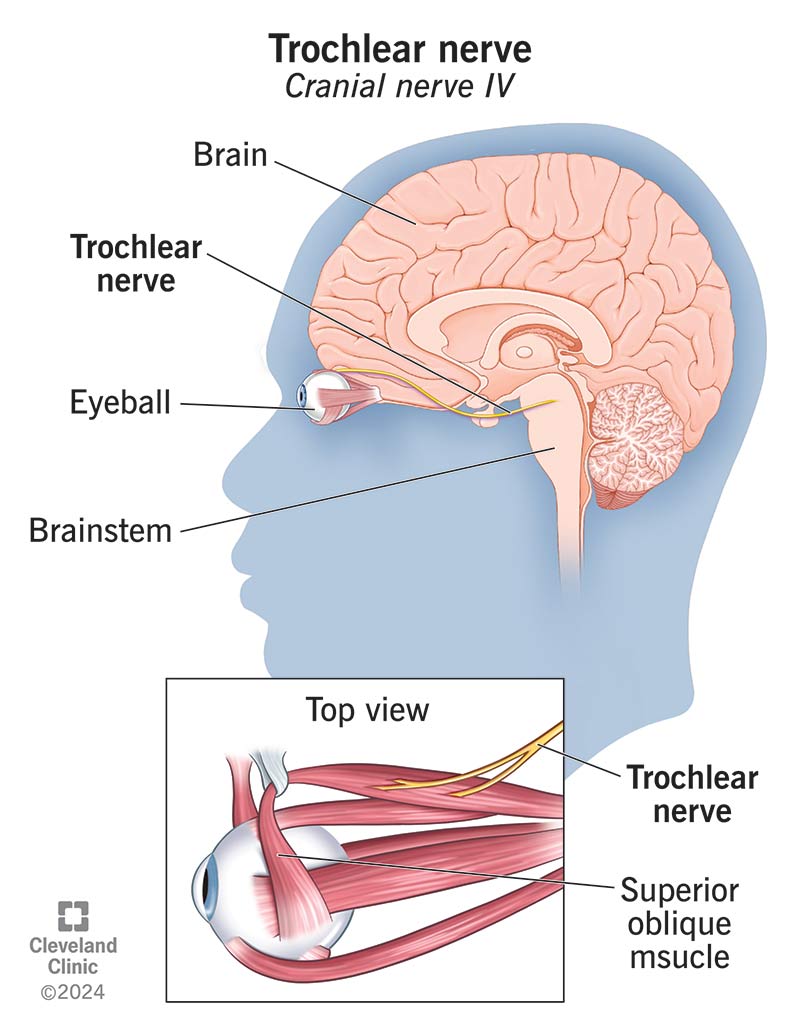Your trochlear nerve is one of 12 sets of cranial nerves. It enables movement in your eye’s superior oblique muscle. This makes it possible to look down. The nerve also allows you to move your eyes toward your nose or away from it.
Advertisement
Cleveland Clinic is a non-profit academic medical center. Advertising on our site helps support our mission. We do not endorse non-Cleveland Clinic products or services. Policy

Your trochlear nerve, also known as the cranial nerve 4 or CN IV, is a motor (movement) nerve that sends signals from your brain to one of the muscles that control eye movement. You have two trochlear nerves — one for each eye. They’re one of 12 sets of cranial nerves.
Advertisement
Cleveland Clinic is a non-profit academic medical center. Advertising on our site helps support our mission. We do not endorse non-Cleveland Clinic products or services. Policy
Nerves are like cables that carry electrical impulses between your brain and the rest of your body. Many nerves provide sensory information (like touch and temperature sensations) and movement information. Your trochlear nerve is just responsible for movement.
Your trochlear nerve has one job: To supply movement (motor) information to your superior oblique muscle. Together, your trochlear nerve and superior oblique muscle make it possible for you to look down. They also enable you to move your eyes toward your nose or away from it.
The trochlear nerve gets its name from the Latin word “trochleae,” which means “pulley.” A pulley is a device that helps lift and lower an object. Your trochlear nerve controls (innervates) your superior oblique muscle, which is connected to your eye near the top of it. This muscle goes through a sling of connective tissue that acts as a pulley.
Other nerves that control voluntary eye movement include your:
Even though your trochlear nerve (CN IV) is only responsible for controlling your superior oblique muscle, it has a relatively long course to get to this muscle. Your trochlear nerve starts in your brainstem. It passes through four areas before reaching your superior oblique muscle near the top of your eyeball. These areas include:
Advertisement
If your trochlear nerve experiences damage, it’ll likely affect your eye movement and vision. Common signs of trochlear nerve damage (often called fourth nerve palsy or trochlear nerve palsy) include:
Your trochlear nerve has a very long path through your head. This makes it vulnerable to injury — more so than other cranial nerves. It’s especially vulnerable to damage from head trauma. Common causes include vehicle accidents and boxing. But even mild head injuries can lead to damage.
Other less common causes of trochlear nerve damage include:
Some babies are born with trochlear nerve issues. Healthcare providers call this congenital fourth nerve palsy.
Some causes of trochlear nerve damage are unpreventable, like congenital (present from birth) conditions that affect the nerve. But you can take steps to prevent head injuries that could damage your trochlear nerve. These include:
Other steps that can help keep your nerves healthy in general include:
Advertisement
Contact your healthcare provider if you experience symptoms of fourth nerve (trochlear nerve) palsy. They often include vision changes that worsen when you look down, like blurry or double vision.
Every time you look down or away or toward your nose, you can thank your trochlear nerve for doing its job. But if you develop double vision or have to tilt your head to see properly, it may be due to trochlear nerve damage. Reach out to a healthcare provider if this happens. They can do some tests and assessments to see if you have trochlear nerve palsy.
Advertisement
If you have a neurological condition, you want expert advice. At Cleveland Clinic, we’ll work to create a treatment plan that’s right for you.

Last reviewed on 07/22/2024.
Learn more about the Health Library and our editorial process.